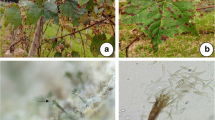Abstract
Many weeds, includingSenecio vulgaris, are virtually symptomless hosts ofVerticillium albo-atrum. Plants ofSenecio vulgaris were inoculated with spore suspensions ofV. albo-atrum by two different methods: root-dipping or injection. Infected plants rarely wilted but were stunted, their lower leaves died prematurely and numbers of lateral shoots were decreased.V. albo-atrum was isolated from all parts of the host including achenes. When placed on agar, infected achenes germinated more rapidly than healthy ones. Only small amounts of mycelium developed in the vessels. Severe wilting was possibly avoided because there is insufficient time for damaging amounts of mycelium to develop inSenecio which has a short period of vegetative growth. On the other hand its tolerance to infection may be attributed to the morphology of its vascular system with its narrow vessels and sparse parenchyma cells.
Similar content being viewed by others
References
Dimond, A. E. &P. E. Waggoner,—1953. On the nature and role of vivotoxins in plant disease. Phytopathology 43: 229–235.
Ende, G. van den,—1956. De reacties van verschillende waardplanten bij aantasting door Verticillium spp. Tijdschr. PlZiekt. 62: 21.
Ende, G. van den,—1958. Untersuchungen über den Pflanzenparasieten Verticillium albo-atrum Reinke et Berth. Acta bot. neerl. 7: 665–740.
Engelhard, A. W.,—1957. Host index of Verticillium albo-atrum Reinke et Berth. (including Verticillium dahliae Kleb.). Plant Dis. Reptr, Suppl. 244: 23–49.
Harris, R. V.,—1956. Verticillium of hops. Rep. E. Malling Res. Sta. 1955: 38–39.
Meer, J. H. H. van der,—1925. Verticillium-wilt of herbaceous and woody plants. Meded. LandbHogesch., Wageningen 28: 1–82.
Rudolph, B. A.,—1931. Verticillium hadromycosis. Hilgardia 5: 197–353.
Sackston, W. E. &J. W. Martens,—1959. Dissemination of Verticillium albo-atrum on seed of sunflower (Helianthus annuus). Can. J. Bot. 37: 759–768.
Schuster, M. L. &D. S. Nuland,—1960. Seed transmission of safflower Verticillium wilt fungus. Plant Dis. Reptr 44: 901–903.
Suchorukow, K. T.,—1958. Beiträge zur Physiologie der pflanzlichen Resistenz. Akad. Verlag Berlin: 1–115.
Author information
Authors and Affiliations
Additional information
In co-operation withH. van Geest, J. P. Overdulve andC. J. J. Richter.
Rights and permissions
About this article
Cite this article
Matta, A., Kerling, L.C.P. Verticillium albo-atrum as a parasite ofSenecio vulgaris . Netherlands Journal of Plant Pathology 70, 27–32 (1964). https://doi.org/10.1007/BF02102384
Accepted:
Issue Date:
DOI: https://doi.org/10.1007/BF02102384




